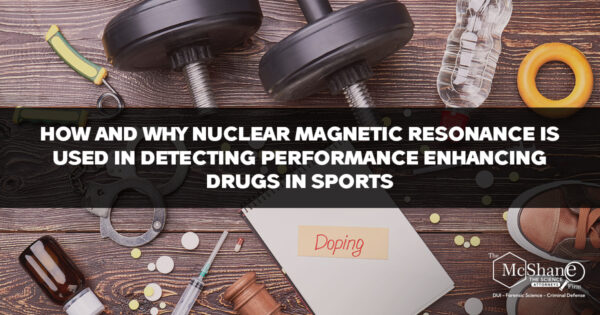Nuclear magnetic resonance (NMR) is a highly sensitive and non-destructive analytical technique that provides detailed information about the molecular structure, dynamics, and chemical environment of a compound. NMR is based on the interaction between atomic nuclei possessing a magnetic moment (e.g., 1H, 13C, 15N) and an external magnetic field. In the context of detecting performance-enhancing drugs in sports, NMR is employed to identify and characterize known and unknown doping agents, as well as to study their metabolic pathways and degradation products.

The NMR technique involves the following steps:
- Sample preparation: An athlete’s biological sample (e.g., urine, blood, or saliva) is prepared by extracting and purifying the target compounds using techniques such as liquid-liquid extraction (LLE), solid-phase extraction (SPE), or protein precipitation.
- Application of an external magnetic field: The prepared sample is placed in a strong, homogeneous external magnetic field generated by a superconducting magnet. The magnetic field causes the magnetic moments of the nuclei to align either with or against the field.
- Radiofrequency (RF) pulse excitation: An RF pulse is applied to the sample, which temporarily disturbs the equilibrium of the aligned magnetic moments. This causes the nuclei to precess around the magnetic field at a frequency called the Larmor frequency, which is characteristic of the specific nucleus and its chemical environment.
- Detection of the NMR signal: As the disturbed nuclei return to their equilibrium state, they emit RF signals that can be detected by a sensitive NMR probe. The emitted signals, called free induction decays (FIDs), are complex mixtures of frequencies corresponding to the precession frequencies of the various nuclei in the sample.
- Fourier transformation and spectrum analysis: The time-domain FID signals are converted into the frequency-domain NMR spectra through a mathematical process called Fourier transformation. The NMR spectra display peaks corresponding to the different resonant frequencies of the nuclei in the sample, providing information on the chemical structure and environment of the target compounds.
- Identification and quantification: The NMR spectra are analyzed to identify and quantify the presence of performance-enhancing drugs or their metabolites in the sample. The chemical shifts, coupling constants, and peak intensities in the spectra provide valuable information about the structure and concentration of the target compounds.
In doping control, NMR is particularly useful for:
- Identifying known doping agents and their metabolites in biological samples.
- Characterizing unknown or designer drugs, providing insight into their chemical structures and aiding in the development of detection methods.
- Studying metabolic pathways of performance-enhancing drugs, which can help in identifying specific biomarkers for doping detection.
- Verifying the structure and purity of reference standards used in other analytical techniques, such as mass spectrometry.
Nuclear magnetic resonance (NMR) is especially useful for detecting banned substances that have complex structures, unknown compounds, or substances that require structural elucidation for identification. While NMR is less sensitive than other techniques like mass spectrometry or chromatography, it provides a wealth of information about the molecular structure and chemical environment of compounds, making it invaluable in certain situations. Some examples of banned substances that can benefit from NMR analysis include:
- Designer drugs: NMR is highly effective in characterizing unknown or designer drugs, providing insight into their chemical structures and aiding in the development of detection methods. Since designer drugs are often modified versions of known performance-enhancing substances, identifying their structures is essential for developing targeted detection strategies.
- Peptide hormones and their analogs: Peptide hormones, such as growth hormone (GH) and insulin-like growth factors (IGFs), have complex structures that can be challenging to analyze using other techniques. NMR can help determine the structure of these peptides and their analogs, enabling anti-doping laboratories to develop effective detection methods.
- Protein-based doping agents: NMR can provide detailed structural information about protein-based doping agents, such as erythropoietin (EPO) and its various isoforms. Understanding the structure of these proteins can help differentiate between endogenous and recombinant forms, which is crucial for doping detection.
- Metabolites and degradation products: NMR can be used to study the metabolic pathways of performance-enhancing drugs, identifying their metabolites and degradation products. This information can be used to develop targeted detection methods based on the presence of specific biomarkers in athletes’ samples.
- Complex mixtures and impurities: NMR can be used to analyze complex mixtures of substances, helping to identify individual components and impurities in the sample. This is particularly useful when dealing with substances that may have multiple active ingredients or contaminants that can affect the overall performance-enhancing effects of the substance.
While NMR is a powerful tool for detecting and characterizing banned substances, it is often used in combination with other analytical techniques, such as mass spectrometry or chromatography, for a more comprehensive and sensitive analysis. Each technique has its strengths and limitations, and the choice of method depends on the specific substance and the analytical requirements of the doping control laboratory.
NMR offers high specificity and the ability to detect multiple compounds simultaneously, making it a valuable tool in the fight against doping in sports. However, due to its relatively low sensitivity compared to techniques like mass spectrometry, NMR is often used in conjunction with other analytical methods for a more comprehensive analysis.


